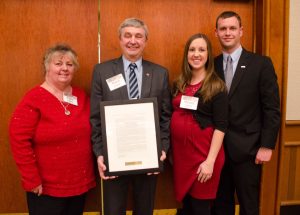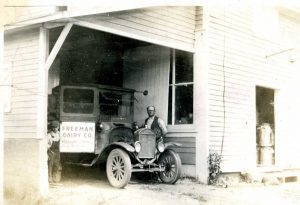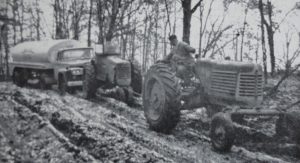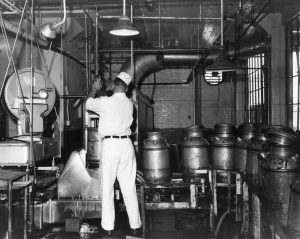
When the milk truck turns off the driveway and passes the old bank barn, it’s easy to step back and let the haulers, processors and marketers complete the supply chain. But MMPA Member Hank Choate keeps his eye on the entire milk route, knowing consumer demand for dairy is what truly milks the cow. A dairy farmer with 47 years of experience, Choate is a fervent promoter of dairy and agriculture.
In recognition of his passion for dairy, involvement in the industry and accomplishments on the farm, Choate was recently recognized by the Michigan State University (MSU) Department of Animal Science with the 2016 Dairy Farmer of the Year award.
“I am completely humbled by this award from MSU. I see myself no different than any other producer because I know we all work hard to provide safe, wholesome and nutritious product for the world. I, along with other farmers, take great pride in fulfilling that need,” Choate admits.
Efficiency for Seven Generations
Choate farms with his brother, Randy, son, Levi, nephew, Rick, and seven full time employees on Choate’s Belly Acres. In addition to Levi, Choate and his wife, Katie, have two other children: Stacey, who also assists on the farm, and Dustin, who is a student at Davenport University. Choate and Randy—who took over ownership in 1989—are forming an operating LLC and to enable family members to have ownership.
The family’s history on their land in Cement City, Michigan, dates back seven generations to 1837 when the Choate homestead was founded. Choate purchased the homestead from his cousin in 1996 adding it to the main operation established in 1913. Now, all 2,000 tillable acres of Choate’s Belly Acres span three different counties. The farm underwent recent expansions in 2008 and 2012, bringing the milking herd up to 435 cows housed in new and enlarged freestall barns.

The farm continues to maximize efficiencies in various areas of their operation, using Standard Operating Procedures (SOPs) to ensure consistency and accuracy. They maximize feed efficiency through a feed watch system and the assistance of their nutritionist. All forages are grown on their land and the farm brings in additional revenue from cash cropping. Variable planting rates, grid soil sampling and variable application of fertilizer help keep their cropping operations efficient and sustainable.
For the last decade and a half, Choate’s Belly Acres has remained 100 percent Artificial Insemination (AI) to breed their cows, with the use of double ovsynch timed breeding. They also rely on weekly check-ins with their veterinarian to assist with breeding and other herd health concerns.
“We emphasize productivity and efficiency in everything we do, by maximizing comfort and minimizing stress of the animals. As best we can, we focus on the bottom line and strive for financial sustainability,” Choate explained.
From the days of crawling between the cows as two-year-old in the stanchion barn to present day as the farm’s CEO, Choate’s role has evolved in the family business. Today, every morning starts at 3:00 a.m. in front of the glow of a computer screen. Choate monitors market reports and data on his cattle before going out into the barn to keep up with his chores, his cows and his employees. Through time, he has become more a manager of people than a manager of cows.
“I’m still on my first job. Ever since I aced sandbox in kindergarten, I’ve known what I’ve wanted to do, Choate revealed. “I’m fortunate to have a family legacy built before me and I hope to lay solid foundation for the next generation so the farm will reach its 200th year.”
Promoting for the Next Generation
Choate knows the key to ensuring a strong foundation for the next generation: dairy promotion.
“I’m committed to being a consumer advocate and spokesperson for agriculture because some organizations and groups of people try to tell our story in a jaded manner. Activists against us have a slanted agenda,” he affirmed.
Chaote’s passion has fueled his active involvement in dairy promotion at the local and state level through programs like the Jackson County Fall Fest and MSU Extension’s Breakfast on the Farm. In 2012, Choate’s Belly Acres hosted Breakfast on the Farm and welcomed 2,675 people to the farm for three hours of fun educational activities. Choate continues to be involved in Breakfast on the Farm as a member of the statewide planning council and convincing fellow farmers to become a host.
“The beauty of Breakfast on the Farm is that it is producer-driven. Being there and sharing our story allows us to put a face of producers on a product,” Choate said. “The program is a great way to continue to build on consumer confidence. If I lose the confidence of consumer, there’s nothing I can do efficiently on my farm to make up for the loss in demand.”
In addition to Breakfast on the Farm, his participation in MSU Extension has provided many opportunities including training on nutrition, finance, management, soils and crops.
“It is humbling to be chosen as the MSU Dairy Farmer of the Year, as I have no formal education beyond high school,” Choate revealed. “MSU Extension programs have been the basis of furthering my education. I’ve also learned through involvement in the industry and observing other agriculture leaders and how they engage in finding solutions.”
Choate holds various leadership positions in the agriculture industry, including organizations such as MMPA, Michigan Farm Bureau and Green Stone Farm Credit. Since 2012, Choate has represented District 1 on the MMPA board of directors.
“In today’s economy, it’s important I meet my obligations to MMPA members as a board member. I take seriously our due diligence,” Choate relayed. “If we make the right decisions for today, it will carry us to the next 100 years. The dairy industry is definitely in time of challenge, but over its 100 years the co-op has navigated many challenges and survived. We are strengthening the co-op as we move forward.”
From efficiency on the farm to dairy promotion and industry involvement, Choate is one dairy farmer committed to his passions.
“As farmers we’re connected to the earth,” Choate illustrated. “It gives us a set of accomplishment and pride every day.”



